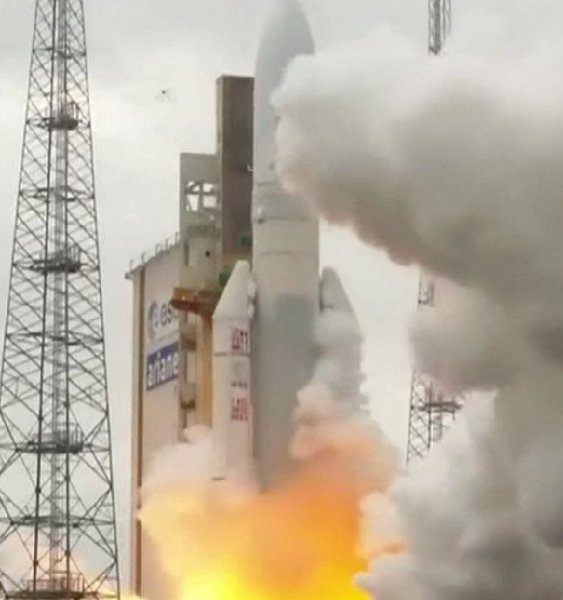



The James Webb Space Telescope had a perfect launch on its ‘voyage back to the birth of the universe’. It is planned to succeed the Hubble Space Telescope as NASA’s flagship mission in astrophysics and designed to answer unsolved questions about the universe. It will look further back in time than ever before to 400 million years after the Big Bang and will enable investigations in astronomy and cosmology, observing distant events and objects, such as the formation of the first galaxies, and providing detailed atmospheric characterization of potentially habitable exoplanets.
Development began in 1996 for a 2007 launch with a US$500 million budget but delays, cost over runs and several possible cancellations along the way, ended up with a $10bn (£7.5bn) budget and the launch on 25 December 2021 from Kourou spaceport in French Guiana at 12.20pm UTC.
The chart isn’t quite as well tied together as the Hubble Telescope launched on 24 April 1990 12.33pm Merritt Island, Florida, which has two talented Half Grand Sextiles.
But both charts oddly have their respective Suns at a 4 degree Earth sign – Hubble in Taurus and Webb in Capricorn. Hubble has the North Node at 12 degrees Aquarius and Webb has Saturn at 11 Aquarius. Both have the researching, communicative Mercury at roughly the same degree Earth sign.
Not sure what all this adds up to and I confess I have not the remotest idea how telescopes manage to time travel backwards but it will be interesting to watch.

So far, deployment has been problem free. I wish them all the best!
Thank you, Marjorie. I appreciated the Hubble launch and James Webb’s chart details. I admit that Saturn on the ascendant, ruling the ascendant and linking the chart so closely to the Saturn-Uranus square (being launched about a day after its final exact aspect) makes me very nervous given that aspect has been linked to other structural failures. (Think Miami condo collapse.) I think astrologers want to see Webb succeed as much as astronomers so here’s hoping it does express the positive qualities of the Saturn-Uranus square.
The simplest explanation is that there is a limit to the speed of light. This means the light of distant galaxies takes billions of years to get here. If they exploded or disappeared now, it would take billions of years to find out. Closer to home, it takes eight minutes for the light of the Sun to reach our planet. If it blew up, it would take eight minutes to find out.
Hi, Marjorie
Re. your last paragraph – it’s simple really. Light travels at a finite speed – 186.000 miles per second, and a light year is the distance that light travels in a year, which is, er, quite a long way. So when astronomers talk about their telescopes seeing an object 100 light years away, what they really mean is that they’re seeing something that was there 100 years ago.
Sorry, that should be a comma – 186,000
Re “time travel”. It takes time for light to travel. When we look at stars (and planets) in the sky, we are observing light from an earlier time. That could be measured in seconds, minutes, and hours, as with planets in our solar system, or years when looking at stars. A telescope in space simply has a clearer view of stars and galaxies than a telescope on earth. When they say the Webb telescope can see further back in time, they are referring to the clarity aspect, which enables the ability to discern finer detail than before. In practice this means more galaxies can be observed, from which the light received will be 100’s of million years old. That’s as good as it gets. We have no idea what’s going on with these galaxies right now, if indeed there is a “right now.” (Einstein had something to say about this.)
Let’s hope it does not have any mirror flaws like that gremlined the Hubble. Once in-place in orbit, there are no service calls.
It’s mind blowing! Curiously, the human James Webb, the second administrator of NASA, had natal Uranus at 4 Capricorn (7 October 1906) – connecting with yesterday’s launch Sun for a symbol of invention made tangible. His Nodes were 9 Leo/Aquarius, while his natal Sun at 12 Libra aspects both Hubble’s Nodes, and the launch date’s Saturn in Aquarius – perhaps symbolising his telescopic namesake both making history, and bringing us knowledge of the deepest history imaginable.
I think this event is a positive manifestation of the Saturn/Uranus square in a way. Hope that Saturn in Aquarius means long-lasting exploration here, and Uranus in Taurus reveals or revolutionises our views of the Universe, and our own planet Earth.
Thanks. I couldn’t find his date when I looked yesterday. Have added his chart.
https://webbtelescope.org/resource-gallery/articles/pagecontent/filter-articles/how-does-webb-see-back-in-time?filterUUID=a776e097-0c60-421c-baec-1d8ad049bfb0
Thanks for that. I think I kinda get it – but it is seriously mind-bending stuff.
I think the analogy for time travel is to think of the TV programmes that were broadcast in the 1960s. The radio waves for those are still travelling off into the universe. Therefore if you could put a TV far enough way from the Earth, those 60s shows would be arriving and showing on it and we could watch them through the telescope.